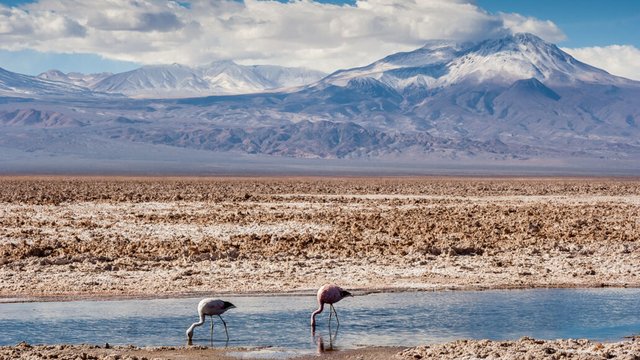Lithium mining may be putting some flamingos in Chile at risk
Flamingos may be a kind of canary in the coal mine when it comes to warning of a hidden cost of green technologies. Lithium mining appears to be a major threat to the iconic pink birds that rely on ecologically fragile salt flats bordering the high Andes Mountains. Mining of the metal and climate change together are causing the decline of two flamingo species found only on Andean plateaus, researchers report March 9 in the Proceedings of the Royal Society B.
Lithium, used in lightweight, rechargeable batteries for electric cars, smartphones and other items, is expected to play a major role in helping fight climate change. Within the next decade or so, global demand for the metal is estimated to quadruple (SN: 5/7/19). The new finding highlights that the quest for lithium is not without drawbacks, fitting into a growing body of research revealing lithium mining’s adverse impacts on ecosystems.
One of the world’s richest deposits of lithium spans parts of Chile, Bolivia and Argentina, an area sometimes referred to as the “lithium triangle.” The region is also home to the Atacama Desert plateau, one of the driest places on Earth, and hosts a series of shallow, salt flat lake ecosystems that depend on the limited water supply. These ecologically sensitive “salares” nourish cyanobacteria and diatom algae, which in turn are eaten by three types of flamingos, half of the world’s flamingo species.
This fragile ecosystem is now in an existential conflict because lithium refinement ponds and other industrial mining processes use a massive amount of water — an estimated 400,000 liters per ton of lithium, says Nathan Senner, a population ecologist at the University of South Carolina in Columbia.
And there’s only so much water to go around. “This is literally the driest desert in the world,” Senner says. “Much of that [mining] water has to come from groundwater.”
Senner — with ecologist Jorge Gutiérrez of the University of Extremadura in Spain and bird ecologist Juan Navedo of the Austral University of Chile in Valdivia and others — gathered over 30 years’ worth of flamingo surveys. The researchers also examined satellite imagery tracking water surface area changes in five salt flats in the Chilean portion of the lithium triangle. And the team tracked cyanobacteria levels using satellite data, along with climatic factors that could influence the salt flats’ water levels, such as precipitation and temperature.
Senner and his colleagues found that since 1984, the five salares have each shrunk by at least 30 percent in surface area, partially due to increased evaporation, which is influenced by climatic factors like wind, humidity and temperature. The team also found that there’s a great deal of variability in water level between years. And those fluctuations appear to strongly dictate the number of flamingos in a given year by determining the availability of the birds’ food.
Flamingo counts “can change by literally thousands of individuals across just a couple of years,” Senner says.
The long-term drying trend from climate change, which may reduce overall availability of food for flamingos, is being exacerbated by ever-thirsty lithium mining, the team says. And it’s leaving a mark on two of the flamingo species: the Andean (Phoenicoparrus andinus) and the James’ (P. jamesi) flamingos, whose populations declined 12 percent and 10 percent over 11 years, respectively, in Chile’s Salar de Atacama. This is a loss of hundreds of birds.

The team ties this decline directly to lithium mining. As the mining ponds grew in the Salar, nearby James’ and Andean flamingo populations dwindled in tight correlation. Water loss from new mining activity may be a major culprit. Between 1986 and 2018, the groundwater pumping for lithium production increased from zero to 1.8 cubic meters per second. Simultaneously, the Salar lost about five football fields’ worth of surface area every year.
Though the declines didn’t occur over the entire region, the findings are especially concerning for these two species because they don’t live anyplace else in the world. “They are entirely wedded to these saline lakes,” Senner says.
Flamingo declines and salar drying could have reverberating effects on people too since the popular, flamingo-based ecotourism in the region would probably suffer, the team says.
"Science-based conservation management guidelines might still allow future preservation of some key hypersaline systems in the region,” says Mattia Saccò, an ecologist at Curtin University in Perth, Australia, who was not involved with the research.
As the need for lithium is set to rise for use in technologies like electric vehicles, the threat to the flamingos may only increase.
“It’s a real conundrum because obviously no one is going to argue that climate change is not this monster that we need to contend with,” Senner says. Still, as this study suggests, the technologies that could help humankind combat climate change may have their own suite of negative ecological effects. Being aware of those consequences is going to be crucial to weighing the costs and benefits of such solutions, Senner says.
Read the article from here- https://www.sciencenews.org/article/lithium-mining-flamingo-technology-climate-change